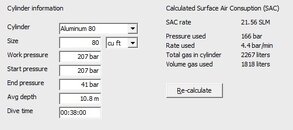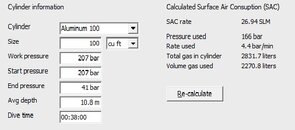Not bad --I have a cold water reference Surface Consumption Rate (SCR) of 22 litres/min (roughly 0.75 cuft/min in US Imperial units). This is an acceptable reference point for now, because it just happens to make your gas consumption planning in Metric --both pre-dive and during the dive on-the-fly calculations-- that much easier & intuitive.
The common AL80 Tank holds 11 litres volume at the surface standard of 1 ATA (or 1.01 bar), for a metric rating of 11 litres/bar.
22 [-]litres[/-]/min divided-by 11 [-]litres[/-]/bar equals 2bar/min SCR (Surface Consumption Rate) in pressure units --a more useful quantity to utilize during the dive since your SPG reads in bar pressure units.
Your depth in meters, which converts easily to ATA (simply divide-by-10 and add 1) becomes your multiplier depth factor for your 2bar/min pressure SCR.
Example: 30m depth is 4 ATA; your 2bar/min SCR at depth -or Depth Consumption Rate (DCR)- now becomes 8bar/min. [4 times 2bar/min equals 8bar/min]. So 10 minutes at depth 30m on an AL80 (11L/bar) tank in nominal conditions, you would expect to consume 80bar of gas and your SPG reading to be down or show a delta of 80bar. . .
What if your SCR, or Depth Consumption Rate (DCR) is lower or better than the example above? --Just scale it as a percentage result:
My SCR/RMV in tropical warm waters is typically 30% better than it is in temperate cold SoCal homewaters. However, after a week drift diving in Palau 30deg C water temp, I've lowered that to around 50% of my nominal cold water SCR (from 22 litres/min to 11 litres/min).
This is how I used this value with a 11 litres/bar tank (i.e. an AL80) in Palau:
11 litres/min divided-by- 11 litres/bar equals 1 bar/min pressure SCR.
All my dives are averaging 20 meters depth going with the drift current; 20 meters is 3 ATA (divide 20 by 10 and add 1 gives a depth in atmospheres absolute of 3 ATA).
Therefore 1bar/min multiplied by 3 ATA equals a depth consumption rate of 3 bar/min at 20 meters. Checking my bottom timer every 10 minutes, I expect to consume 30 bar (3 bar/min multiplied by 10min equals 30 bar), and accordingly my SPG should read 30 bar less in that 10 minute time frame.
So by 30 minutes elapsed dive time at 20 meters, I expect to be down 90 bar or at half tank (AL80 full tank is 200 bar). At 40 minutes elapsed time, I'm ascending off the wall into the shallow coral plateau around 9 meters (down 120 bar from 200 bar total, or 80 bar remaining in tank). And finally at the 45 to 50 minute mark, I'm at 6m and my 3-5min safety stop with 60 to 70 bar left. I surface and I know even before looking at my SPG that I have around 50 bar remaining in my tank.
This is how you should actively use your SCR with your particular tank, knowing how much breathing gas you have left, not just only pre-planning, but also during the actual dive real-time-on-the-fly --all with easier to use metric units . . .additionally, you have a SPG that reads in units of pressure: why not convert your SCR to a Depth Consumption Rate (DCR) in pressure units to make use of it???
---------- Post added ----------
More tips & tricks with having a 22 litre/min SCR for reference:
Parameters:
Surface Consumption Rate (SCR):
22 litres/min*ATA
Twin 11 litre tanks (double AL80's): 22 litres/bar total tank rating.
Now divide SCR by total tank rating (22 divided by 22).
You get: 1 bar/min*ATA.
This is how you use the value 1 bar/min * ATA:
(Note: depth in ATA = depth in meters/10 + 1)
18m depth, same as 2.8 ATA -->translates directly to 2.8 bar/min
21m depth, same as 3.1 ATA -->translates directly to 3.1 bar/min
24m depth, same as 3.4 ATA -->translates directly to 3.4 bar/min
27m depth, same as 3.7 ATA -->translates directly to 3.7 bar/min
30m depth, same as 4.0 ATA -->translates directly to 4.0 bar/min
So for an arbitrary & convenient time period of 10 minutes, at each particular depth of the range of depths listed above, you would expect to consume:
2.8 bar/min*(10min) = 28 bar
3.1 bar/min*(10min) = 31 bar
3.4 bar/min*(10min) = 34 bar
3.7 bar/min*(10min) = 37 bar
4.0 bar/min*(10min) = 40 bar
Essentially then,
all you need to know is your depth in ATA and your time at that depth, and you'll know instantly how much gas you've consumed in bar --even before looking at your SPG!
_________
A Quick Rock Bottom Calculation and Gas Plan Estimate for Open Water. . .
For double 11 litre tanks (double AL80's) for a total of 22 litres/bar metric tank rating and
a volume Surface Consumption Rate (SCR) of 22 litres/min -same as a pressure SCR of
1 bar/min*ATA- using an example NDL air dive to 30m (4 ATA) depth in Open Water.
Rock Bottom pressure calculation with one minute stops every 3 meters to the surface,
-->Just "tally the ATA's":
4.0
3.7
3.4
3.1
2.8
2.5
2.2
1.9
1.6
1.3
Sum Total: 26.5 --this also happens to be the pressure in bar needed for one person in an emergency contingency to reach the surface.
For two divers: 26.5 multiplied by 2 equals 53 bar Rock Bottom absolute reading remaining on your SPG.
For two experienced divers stressed: 53 bar plus 30% of 53 bar equals 69 bar Rock Bottom SPG reading.
For two novice divers stressed: 53 bar plus 100% of 53 bar equals 106 bar Rock Bottom SPG reading.
If only a single 11L tank instead of double 11L tanks was shared, then multiply the above again by two:
For two divers: 53 bar times 2 equals 106 bar;
For two experienced divers stressed: 69 times 2 equals 138 bar;
For two novice divers stressed: 106 bar times 2 equals
212 bar (!!!)
--->obviously then, two novice divers on single 11L tanks should not be diving to 30m for any significant length of time. . .






